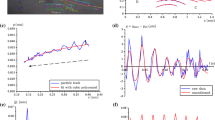Abstract
An experimental system incorporating a computerized micro-impedance unit has been used to make direct measurements of the activity of copepod cephalic appendages. As the appendages are used to both propel the copepod through water and handle particles, it follows that appendage activity reflects feeding behaviour.
To investigate the sensory feeding behaviour of copepods, their activity was recorded with food stimuli varying in size and chemical composition. Sample impedance traces are given for the appendage movements of Temora longicornis in the presence of: 1 — filtered seawater; 2 — beads; 3 — phytoplankton cells; 4 — dissolved free amino acids. The normal appendage movements shown in filtered seawater were modified when copepods were offered particles and dissolved chemicals. Results show that chemical and mechanical stimuli are responsible for the recognition and selection of food. Impedance traces distinguish between behavioural responses such as: antennule flicks, leg kicks, combing, handling and rejection of particles. Spectral analyses of traces have demonstrated that differences in beat pattern are significant.
Similar content being viewed by others
References
Alcaraz, M., G. -A. Paffenhöfer & J. Strickler, 1980. Catching the algae: a first account of visual observations on filter-feeding copepods. In W. C. Kerfoot (ed.), Evolution and Ecology of Zooplankton Communities. The University Press of New England, Hanover (N. H.); Lond.: 241–248.
Bendat, J. S. & A. G. Piersol, 1971. Random data. Analysis and measurement procedures. Wiley Interscience. John Wiley & sons, Inc. Lond.
Buskey, E. J., 1984. Swimming pattern as an indicator of the roles of copepod sensory systems in the recognition of food. Mar. Biol. 79: 165–175.
Cowles, T. J. & J. R. Strickler, 1983. Characterization of feeding activity patterns in the planktonic copepod Centropages typicus under various food concentrations. Limnol. Oceanogr. 28: 106–115.
Friedman, M. M., 1980. Comparative morphology and functional significance of copepod receptors and oral structures. In W. C. Kerfoot (ed.), Evolution and Ecology of Zooplankton Communities. The University Press of New England, Hanover (N. H.), Lond.: 185–197.
Frost, B. W., 1972. Effects of size and concentration of food particles on the feeding behaviour of the marine planktonic copepod Calanus pacificus. Limnol. Oceanogr. 17: 805–815.
Gill, C. W., 1986. Suspected mechano- and chemosensory structures of Temora longicornis (Copepods: Calanoida). Mar. Biol. 93: 449–457.
Gill, C. W., 1987. Recording the beat patterns of the second antennae of calanoid copepods, with a micro-impedance technique. Hydrobiologia, 148: 73–78.
Gill, C. W. & R. P. Harris, 1987. Behavioural responses of the copepods Calanus helgolandicus and Temora longicornis to dinoflagellate diets. J. mar. biol. Ass. U. K. 67: 785–801.
Gill, C. W. & S. A. Poulet, 1986. Utilization of a computerized micro-impendance system for studying the activity of copepod appendages. J. exp. mar. Biol. Ecol. 101: 193–198.
Gill, C. W. & S. A. Poulet, 1988. Responses of copepods to dissolved free amino acids Mar. Ecol. Prog. Ser. (in press).
Harris, R. P., J. Moal, J. F. Samain, V. Martin-Jezequel & S. A. Poulet, 1986. Effects of algal diet on digestive enzyme activity of Calanus helgolandicus. Mar. Biol. 90: 353–361.
Huntley, M. E., K. G. Barthel & J. L. Star, 1983. Particle rejection by Calanus pacificus: discrimination between similarly sized particles. Mar. Biol. 74: 151- 160.
Paffenhöfer, G. -A. & K. B. Van Sant, 1985. The feeding response of a planktonic copepod to quantity and quality of particles. Mar. Ecol. Prog. Ser. 27: 55–65.
Poulet, S. A. & C. W. Gill, 1988. Spectral analyses of movements made by the cephalic appendages of copepods. Mar. Ecol. Prog. Ser. (In Press).
Poulet S. A. & G. Ouellet, 1982. The role of amino acids in the chemosensory swarming and feeding behaviour of marine copepods. J. Plankton Res. 4: 341–361.
Price, H. J. & G. -A. Paffenhöfer, 1984. Effects of feeding experience in the copepod Eucalanus pileatus: a cinematographic study. Mar. Biol. 84: 35–40.
Price, H. J., G. -A. Paffenhöfer & J. R. Strickler, 1983. Modes of cell capture in calanoid copepods. Limnol. Oceanogr. 28: 116–123.
Schmitt, B. C. & B. W. Ache, 1979. Olfaction: responses of a decapod crustacean are enhanced by flicking. Science 205: 204–206.
Yule, A. B. & D. J. Crisp, 1983. A study of feeding behaviour in Temora longicornis Müller (Crustacea: Copepoda). J. exp. mar. Biol. Ecol. 71: 271–282.
Author information
Authors and Affiliations
Rights and permissions
About this article
Cite this article
Gill, C.W., Poulet, S.A. Impedance traces of copepod appendage movements illustrating sensory feeding behaviour. Hydrobiologia 167, 303–310 (1988). https://doi.org/10.1007/BF00026318
Issue Date:
DOI: https://doi.org/10.1007/BF00026318




